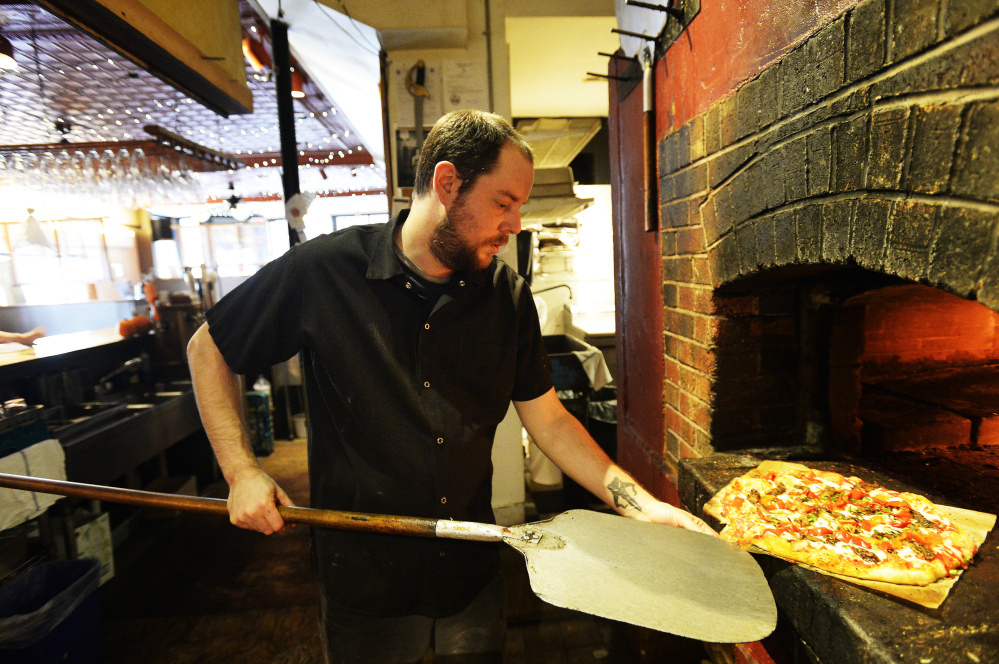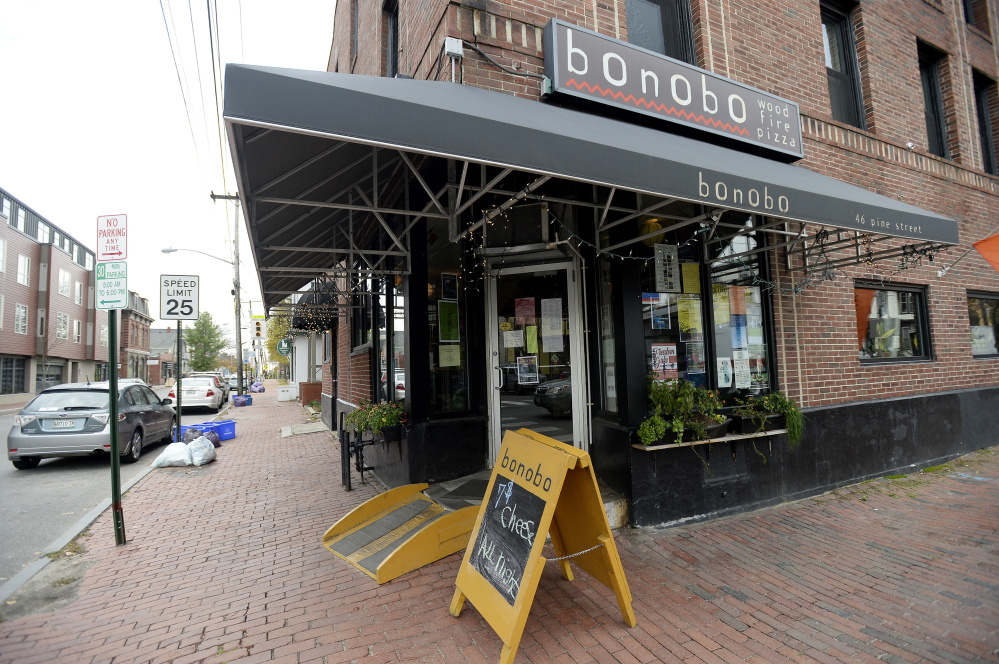As I paid for a to-go dessert – a dense and indulgent pot-de-crème-style cioccolata ($5) – at Bonobo’s bar, I witnessed a blurring of the lines between customers and staff. It wasn’t the first time, and it wasn’t a bad thing.
I watched two different groups of diners walk inside and receive not just a warm greeting, but hugs from servers and host. Earlier, at the rear of the open dining room, I overheard a tipsy customer get a gentle scolding from a staff member: “Sorry, but I’m cutting you off, Tim. I don’t want to have to walk you back home yet again.” And by the time the bartender started spinning a gossipy yarn to two regulars about her biggest customer pet peeve (people who order another drink immediately after she sets one down), I started wondering if I had accidentally shown up for a staff meal or a friends-and-family night. It turns out, this was just an ordinary Thursday at Portland’s Bonobo.
John Nauyokas, one of two chefs at the West End pizzeria, later explained, “We’re in a cush spot in the heart of the West End. Because we’re not downtown, we get lots and lots of regulars. There are customers I see almost every single day. It’s really a small, intimate, neighborhood spot and after a while, I guess we turn into their kitchen.”
If you’re not one of the in-crowd, this particular species of intimacy can sometimes feel a little intimidating. But Bonobo’s front-of-house team is a gregarious bunch, friendly to everyone, not just the people they recognize. It is as true now as it was nine years ago, when our then critic’s four-star review praised the “unpretentious” pizzeria’s excellent service. That’s important, because with a wood-fired brick pizza oven that can fit no more than eight pies at a time (nine in desperation), Bonobo relies on its service staff to keep diners happy as they wait – sometimes 20 to 30 minutes – for their pizzas.
One way to prevent the delay from feeling quite so long is to order a salad. The menu offers two good ones. There’s an unfussy, traditional Caesar salad ($6.75), dressed well and optionally topped with uncured white anchovies that (shhh – don’t tell) are also blitzed into the dressing to create terrific depth of flavor. But the house salad ($6.75) is the more inventive, with chunky, ridge-cut sweet pickles (prepared in-house) and curved strips of shaved endive atop a bed of arugula, romaine and spinach. Perhaps the best thing about the salad is the mustardy, sweet lemon vinaigrette – exactly what the salad needs to counteract bitterness from the arugula and endive.
You’ll find only two salads on the permanent menu, but that’s to make room for some unique pizzas. At any given time, the restaurant has an unchanging roster of 15 pizzas, plus a few seasonal pizzas that change every month or two. While you can indeed find a cheese ($9.75), pepperoni ($12.75) and margherita ($14.25) pie here, those pizzas are merely trail markers to orient you as you navigate a creative menu that includes Bonobo’s eponymous pizza ($17.50), made with leeks, mushrooms and a fontina- based white sauce, as well as a delightfully stinky Taleggio pizza ($17.25) with arugula and smoked tomato sauce.
As you might expect from a restaurant that offers so many varieties, the pies range in quality. Some are decent, like the Goat ($16.75), with sun-dried tomatoes, roasted red peppers, spinach, local goat cheese from Warren, Maine, and two unorthodox pizza ingredients: rosemary and roasted garlic butter. That garlic butter brings out a rich tanginess in the cheese, making it taste like ricotta’s feral ancestor. Sadly, our crust had a few issues around the rim – pushed into and folded up over on itself like tectonic plates at a fault line, it was tough and too dense.
The same was true of the crust on the otherwise fantastic Ocean ($13.50), made with white clam sauce, cream, Parmesan and scallions. Tasting its saline richness, I immediately thought of a clam alfredo. Nauyokas, on the other hand, thinks of it as “a bare-bones clam chowder.” Either way, it’s an enjoyable, if imperfect pie that is let down a bit by its crust.
Better still was the Middle-East-inspired Morocco ($17.50), topped with roasted red peppers, scallions, a blend of feta and goat cheese, and the restaurant’s homemade, honey-sweet spiced lamb sausage. Or the Caspian ($17.50), which with roasted chicken, smoked tomatoes and basil, offered plenty of smoke and clear, fresh basil flavors in every bite. The chicken, which was dried out in spots, was the pizza’s only real flaw.
If there’s a lesson to be learned about putting chicken on a pizza, it should come from the Marley ($17.50), a superb Caribbean-style pie featuring hot and roasted red peppers, scallions, cheddar and a jerk chicken “sausage.” As Nauyokas told me, the kitchen roasts chickens in its brick pizza oven until their skin crisps up, then picks the still-hot birds clean, coats these shredded chicken pieces in a house-made, thick jerk seasoning base and lets them marinate. What results is not so much a traditional sausage as highly seasoned, pulled meat. But when it is used as a topping for pizza, the wet seasoning acts as a protective layer, keeping the chicken as soft and tender as a confit, while giving the crust a chance to turn brown and shatteringly crisp.
Consistency of crust is likely to continue to be a minor problem for Bonobo, because they use a wet dough that is so finicky, it prevents them from using cornmeal to lubricate a pizza’s voyage from peel to oven and back again. Instead, they use baking parchment, which can trap moisture under the bottom crust.
For the sake of consistency, they also compromise on the temperature of their hardwood-fueled stove, keeping it far from its maximum temperature of 700 degrees Fahrenheit, instead maintaining a moderate heat of 500 to 550 – about the same as what you can achieve in most home ranges. It’s an unusual choice for a pizzeria with a supercharged brick oven at hand, and frankly, one that contributes to the length of the wait for pizzas.
At the same time, in a space that’s so homey and comfortable, with staff who go to enormous effort to make diners feel like they belong, it does not seem much of a burden to take a little extra time for dinner. Sit back, order a salad and listen to the kinds of restaurant conversations that normally happen after the front door has been locked for the night. Soon enough, this might become your kitchen, too.
Andrew Ross has written about food in the United Kingdom and in New York, where he co-founded NYCnosh, a food website. He and his work have been featured on Martha Stewart Living Radio and in The New York Times. He is an Internet researcher and higher education consultant. Contact him at andrewross.maine@gmail.com or on Twitter @AndrewRossME.
Send questions/comments to the editors.




